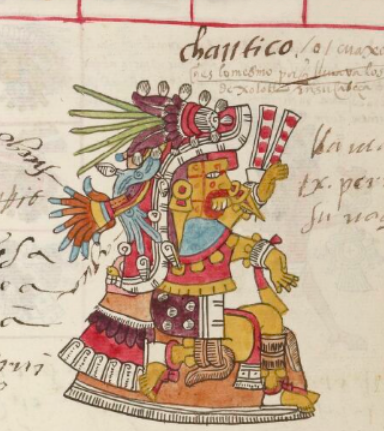Chantico (TR21v)
This example of the iconography of the divine force or deity associated with fire called Chantico ("In the Home") comes from the Codex Telleriano-Remensis. She is shown in profile, facing toward the viewer's right, and with the legs as though ready to move (perhaps dance). She wears a dark purple/brown skirt decorated with round down feathers and a white trim at the bottom, a red blouse with a yellow fringe at the bottom, and what appears to be a turquoise blue quechquemitl on top with red trim and yellow circles along the bottom. Her face is yellow-gold with red lines criss-crossing it and little circles inside the squares that are made by the crossing lines. Her mouth is outlined in red, and her yellow fangs protrude. Her headdress is large and elaborate, going down her back and ending in large turbinate shells. At the top are quetzalli feathers and a cuauhpilolli in purple, red, and white. The interwoven symbol of the diphrasism, in atl in tlachinolli (flood and conflagration) winds down curving through her headdress.
Stephanie Wood
According to the Primeros Memoriales, this divine force was associated with fertility. Joseph Kroger and Patrizia Granziera, Aztec Goddesses and Christian Madonnas (2020), add: "Chantico was the Aztec fire goddess who kept the domestic hearth fire. She was patron of the stone-cutters of Xochimilco and later adopted by the Aztecs and included in their pantheon. She was also considered the creator of jewelry and was associated with fashion and cosmetics" (33).
For more information on the feathered headdress ornament, see Quiñones Kebers' (Codex Telleriano-Remensis, 1995, 186) references to the cuauhpilolli and aztaxelli. The aztaxelli may be like the example below that is made from heron featheres, too (aztatl). See also the quecholli feather device.
It is important to note the symbols of agricultural land on the tlachinolli (scorched earth, conflagration) glyph, for it is the burning of agricultural fields that was especially worrisome of the continuation of life. Note the alternating orange and purple colors, the U-shapes and the dots that suggest parcels and cultivation.
Stephanie Wood
chantico
Chantico
Stephanie Wood
ca. 1550–1563
Jeff Haskett-Wood
feathers, plumas, deidades, divinidades, fuerzas divinas, candalias, cactli
chan(tli), home, https://nahuatl.wired-humanities.org/content/chantli
Chantico, female divine force, https://nahuatl.wired-humanities.org/content/chantico
Telleriano-Remensis Codex, folio 21 recto, MS Mexicain 385, Gallica digital collection, https://gallica.bnf.fr/ark:/12148/btv1b8458267s/f68.item.zoom
The non-commercial reuse of images from the Bibliothèque nationale de France is free as long as the user is in compliance with the legislation in force and provides the citation: “Source gallica.bnf.fr / Bibliothèque nationale de France” or “Source gallica.bnf.fr / BnF.”





